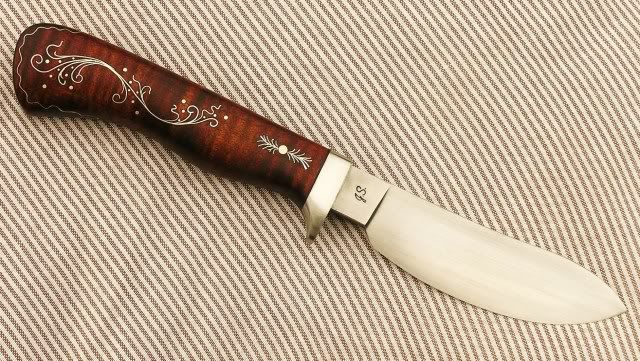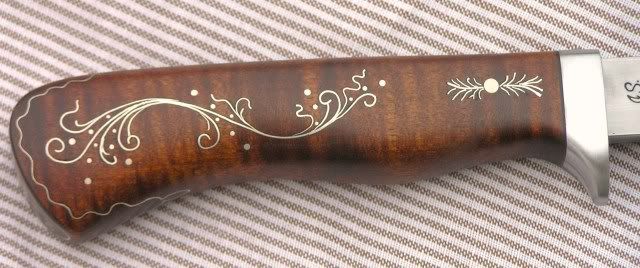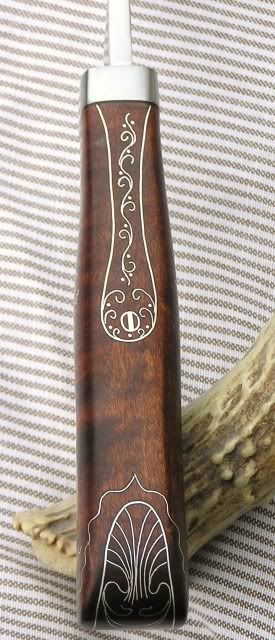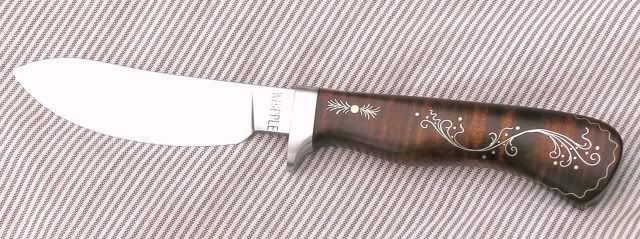
viking-sword
-
Posts
129 -
Joined
-
Last visited
Content Type
Profiles
Forums
Articles
Gallery
Downloads
Events
Posts posted by viking-sword
-
-
Though pressing out is a way to do this, a more common way is to cut out the appropriate size and shape it round and solder or braze a buttjoint closed and dress the joint, then cut out an end cap to fit and braze or solder that piece as well. Soft sheet iron may be soft, but does not have the ductility or sheer strength needed for this project. Just my two cents worth! Wes
-
Another source for almost everything a leatherworker may need( and I almost hate to mention it) is e-bay. You could concievably outfit yourself very well for very little if your not objectionable to this site as many are these days.
-
these art supply clays come in many different colors and are very useful in an unusual way, and what i mean is that i use it to do layering experiments, so that i can determine how a damascus billet will look when it is folded in different ways. this of course makes it disposable in the end, but it takes all the guess work out of the process and is a great way to see the end results.
-
The paper says we got 21inches in 11hrs, in conjuntion with the high winds, it messed up the area pretty good. The airport runways were covered with 6ft drifts. All schools closed and most businesses were as well, didn't get much forging or knifework done today though the way I'm feeling right now I just need a long soak in the tub and a long sleep. Wes
-
Glad to hear all is well Frosty. We experienced the blizzard of a lifetime here all night long, 50 plus mpd winds and heavy snow (whiteout). The old timers who have been here 60 plus years said they have never seen it this bad here before. Had my drive cleaned down to the gravel yesterday at 5pm and woke up to 4.4ft in the drive and the front of the house drifted in almost to the top of the door. took 3 hours to shovel a path for the 4x4 plow, and the next 5hrs using both shovel and plow to get one vehicle out to the road. We usually have bare ground and tons of rain this time of year, must be Al Gore and his global warming thats sitting in my driveway.
-
Hey to all you metalmashers over on the mainland AK! Have ya been getting any ash fallout? Kodiak is on the upwind side of the volcano, but were getting one xxxx of a blizzard at this time!!!! Wes
-
This is really good info for me as I live on an island with a lot if commercial fishing going on so folks are always bringing me long (8 to 10ft) used boat and ship prop shafts of stainless, from 1.5 to 2.5 inches diameter, which may be 30 years old but looks new, so I have a bog pile of these and I don't forge stainless, but now I have an idea of what to do with some of it, thanks, Wes.
-
I hate to type and run, as I'd like to chime in on this one a little more,. I've been running a BIII for the last ten years, and here lately the tracking has been giving me fits. I haven't had the time to delve into it completly to fix it, so I've had to resort to the perverbial quick fix of taking some masking or freezer tape and laying down a couple of rounds(layers) down the center of the idler wheel and it works like a charm in keeping the tracking acurate, It requires changing about once a week at the rate I use it anyway, and although it is temporary, it does do a good job for the time being. Wes
-
Thanks for the explaination, I thought it might be something like that. I'd imagine the nails used would wear away prematurly too as you couldn't use hardened nails and bend them on the hoof to secure them if they were hardened, so I guess it all works out the way it should. Wes
-
Been a blacksmith and knifemaker for twenty plus years, but never did any farrier work, and upon reading this thread my curiosity brought up the question of why, aside from cost perhaps, are horseshoes not made from a higher carbon steel than they are? Wouldn't it seem logical to make them from something that would wear a great deal longer and thus cut down on the frequent need for shoe replacement? Or does that fact compliment the need for regular maintenance as a horse hoof grows and wears? Sorry for my apparent lack of knowledge in this area, but I suppose there's only one way to learn(by asking questions). Wes
-
Been using bearing(52100) steel, from bearings, for a long long time. Most of my bearings come from large machinery or ships. A large majority of them are made by Timken, and they are all good quality. The main thing I've learned to watch for are the roller bearings that are tapered as they are almost always case hardened low carbon and so are thier races by the way, if you forge them out they are very good steel for most anything not needing to be hardened. A powerhammer is a most usfull thing to have for working bearings and thier races down into usable stock and a very bright orange will help the steel move much better, Proper normalizing and annealing right after finish forging will make all the difference in the world when you go to cleaning up, finishing or drilling, and is also paramount to heat treating a blade and avoiding cracking and warpage. Wes
-
You have recieved alot of good advise, but by listening to your last post, my only input would be that it sounds like you may have a stuck ball valve or perhaps a blockage somewhere in the fuel line. Both warrent checking out very carefully, perhaps even having the valves checked out, or, to narrow down the possibilities even faster maybe borrowing another valve or regulator that is known to be workig properly. if that doesent turn up a problem I would definatly take in the bottle itself and have someone certified check out the valve on the bottle, Just my two cents, Wes
-
Ten PSI! Wow, I've run my T- Rex burners for over ten years and I don't think I've ever had them up that high, even for forge welding. For general forging I usually run 3 to 5 psi. The thing you really need to watch is the positioning of the flame nozzle distance in relation to the air adjustment ports. It's a very crucial adjustment for proper air fuel mixture. I can't recall without the references, but I had to experiment to see how it worked best in my forge. I have a separate forge for damascus making and it's a horizontal tube and I run two T-rex's, they generally ruh at 6 to 7 psi. Wes
-
There all exactly right. I grew tired of doing searches not long ago and a few weeks ago I was speaking to Glenn and he happened to mentioned the Archives listing at the bottom of the page, which I rarley get to and so I looked into it and low and behold, I found a very interesting and enjoyable way to spend a few evenings while doing reasearch for the topics that interest me. What you will find is a huge listing of every concievable topics, and a whole lot of the same topics, and each one gives a little different angle to learn from, now, you know that I'm not trying to open your eyes to this because you've been here longer and contributide much more than most, including myself; so I guess I was putting this all down for all the new guy's(and gals) who would not normal find this valuable resource until much later in there wanderings through this site. When I do go through the archives, I generally make myself look into a whole lot more stuff than I would normally, and this gets the thought juices flowing alot. Keep up the posting JR no matter what it is! Wes
-
After sitting through a couple sessions of trying to sharpen all those teeth I am of a mind to think that's right! It's a pain! and since I now have a portable metal cutting bandsaw, I'll just stick to using my bi-metal blades on the wood bandsaw and using them for wood only. Wes
-
Hello:
Knowing a little bit abouit this stuff..I was pattern welding back in 1972..Beau Hickory was pattern welding back in the 1950's....
Up until WWII several shotgun makers were offering pattern welded barrels, and some premium shotgun makers still offer nitro proofed welded barrles today.
Why people say that the process was "lost" is beyond me..In fact the German cutlery makers were doing presentation daggers and swords for the Germans in WWII as well.
In answer to your question...in regards to the US Civil War.. the answer would have to be yes. Given the fact that most steels used by smaller firms then were blister or shear steel, when etched, depending upon the level of refinement on the shear steel, you will get a "pattern" on the lesser refined materials, usually nothing more than straight line laminations. I do not think however that a smith would be manipulating the material for a "regonizable" pattern...
JPH
Just out of curiosity, would you happen to have any photo's, or references to photo's of some of your blades or those of Beu Hickory's pattern welded blades from that far back? I wold love to see some of those! Wes -
You didn't mention what type of problems you were having with this method of HT as far end results, but I can Imagine what they might be. For starters, anytime you anneal, normalize, or quench for the hardening process, you must know what temp you are at each time ,as going by color alone is way too much of an uncertainty,and using a magnet is a much more certain way of knowing what temp you are at, you didn't mention one so I assumed you went by color alone. Another important consideration is the viscosity and temp of your quenching oil so you know if you have a fast or slow quench medium, generally 120 to 150F degrees is good and will give a proper hardness. Finally, when you temper the blade back the most accepted and successful formula is to temper at the proper temp three times for a length of at least two hours each time, allowing it to cool to room temp between sessions. For 5160 I temper at 350 to 400F degrees minimum, and this will give me a good tough edge that will not chip out during use. I'm sure many others will chime in with good advise, but if you need more info , please feel free to ask. Wes
-
Though I've done a search, I could find little on the subject about whether or not anyone tries to resharpen there used bandsaw blades. Over the years, as bandsaw blades go dull, I simply hung them on the wall and aquired new, fresh blades. I have a sixteen inch woodworking bandsaw from grizzly that I've had for nearly ten years, and I use bi-metal blades primarily so that I could cut nonferrous metals for guards and they range from 1/4 to 3/4 inch in width, but I can't see just throwing them away. New blades are not that expensive, but I just can't see not trying to make these used blades servicable again. I've attempted to resharpen one a couple times using a dremal tool with a chainsaw sharpening attachment, but they never seem to work that much better. Anyone out there have any experience with this? Wes
-
Bill Moran first went public with his pattern welded blade in 1972, but he spent a number of years prior experimenting and perfecting the method leading up to it. Wes
-
Soon as I finished reading that I got up and took my best forging hammer, took it to my best anvil, and let her ring three times. Not a bad tradition to start for those fallen, and got up flyin! He will be missed!
-
"Very first class", a really nice balance to that set, all the way! Wes
-
Lith, These guys all make a really good point so I can't expound on alternative burners except to say that I've made my share of burners from many different plans, back when I had time to fiddle with it, and I enjoy doing that, alot. I now own and use three T-rex's and a shorty burner and can only say that there came a time for methat I wanted to do my forge work and knifemaking more than building different equipment to see what might work best for me, and at that point in time I had the money, so I bought the T-rex burners, and I've personally never regreted it for a moment for many reasons. I've never had a problem with them, adjustments are easy, light up is easy and temp control is very easy, they also come up to forging temp pretty fast. The only draw back for me is sometimes I am challenged with maintaining cooler temps with the T-rex, which is why I also bought a Shorty burner, and I use this for a very small forge for forging real delicate pieces and for some heat treating applications. This is just my two cents for what it's worth to ya! Wes
By the way, in case your wondering, I use One T-Rex burner for common forge and two of them for my double burner damascus forge. -
Just finished up this knife which was supposed to be for a customer who had to back out of the order due to financial problems. The 4 inch blade is of 52100, differentially heat treated with a steel guard and curly maple handle decorated with fine silver wire. It also comes with a woodlined leather sheath. Enjoy, Wes




-
Though I don't know if this will help much, I have for the last year been using my 4 and 6 inch post vises with springs from large leghold traps. when I bought replacement springs for the traps I simply took a pair of springs, one inside the other, and set them in place where the normal spring would have gone, they work just fine, and someday soon I'll make proper replacements for both of them. Most good spring steels used for this application must be fully hardened and then tempered at a higher temperature than most common ovens will reach, hence the burning oil method is still used by most folks, and though messy, it's usually very successful. Most folks have a hard time finding a receptical for the oil temper, but I've found that by taking the hardened spring, a quart or three of oil, and an old metal car hubcap, without any holes in it of course, out to a lakeside or country road, and doing this it's not so offensive to anyone. Hope this helps! VS
My New Gas Forge
in Problem Solving
Posted
Excuse me, but(no pun intended), a good propane burner will run on only 3 to 5 pounds of pressure, and I "Know" most of us here can muster up way more than that, and I'll bet a sizable amount of forging can be done before the fuel supply runs out. :):)
:):)